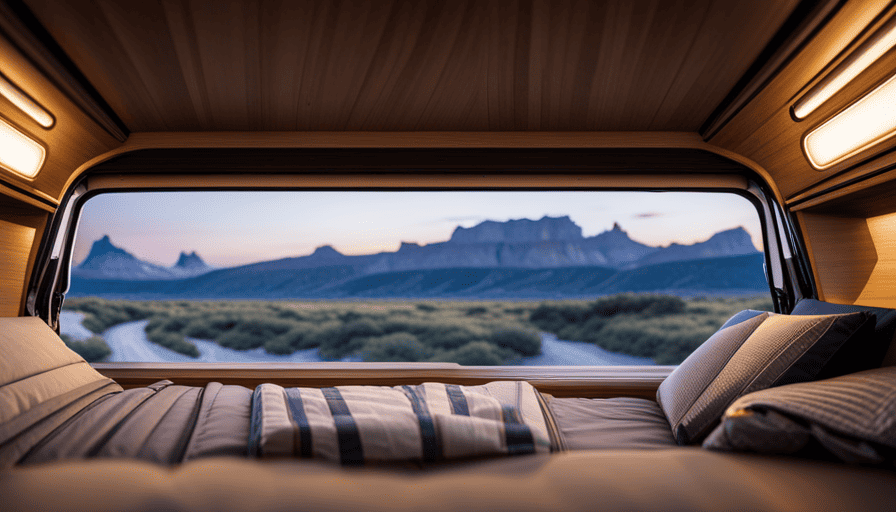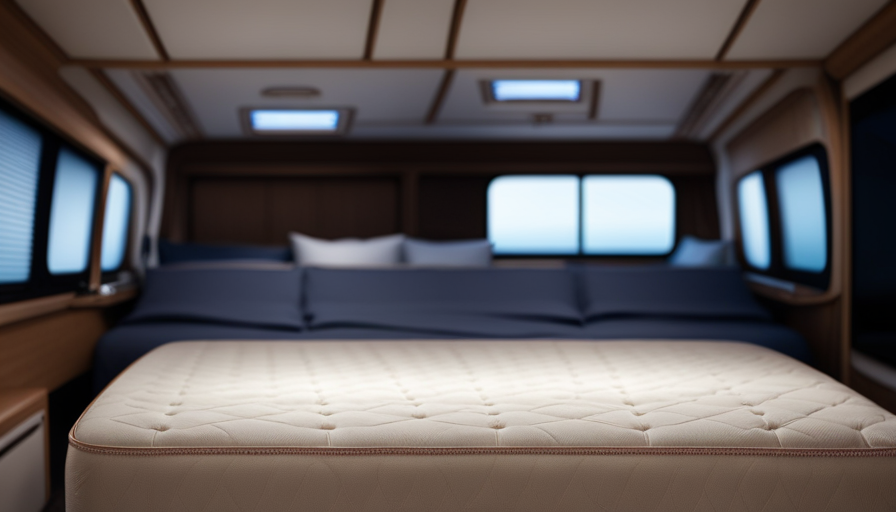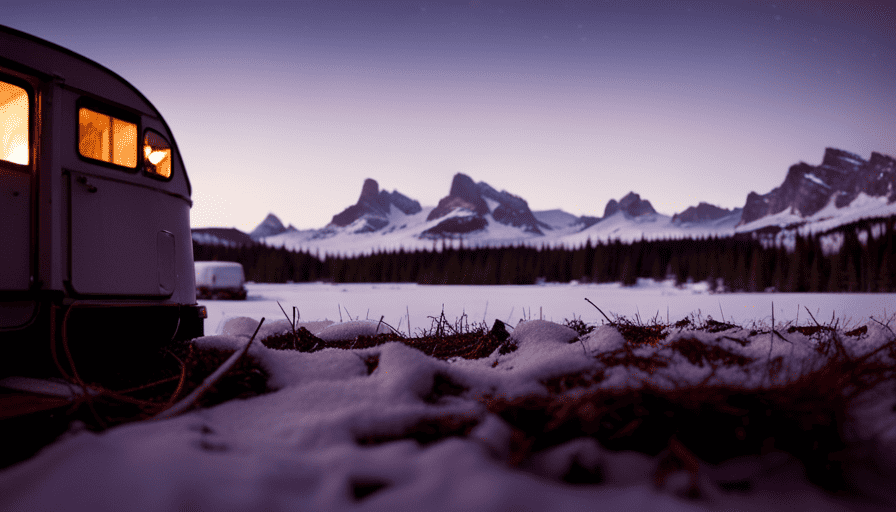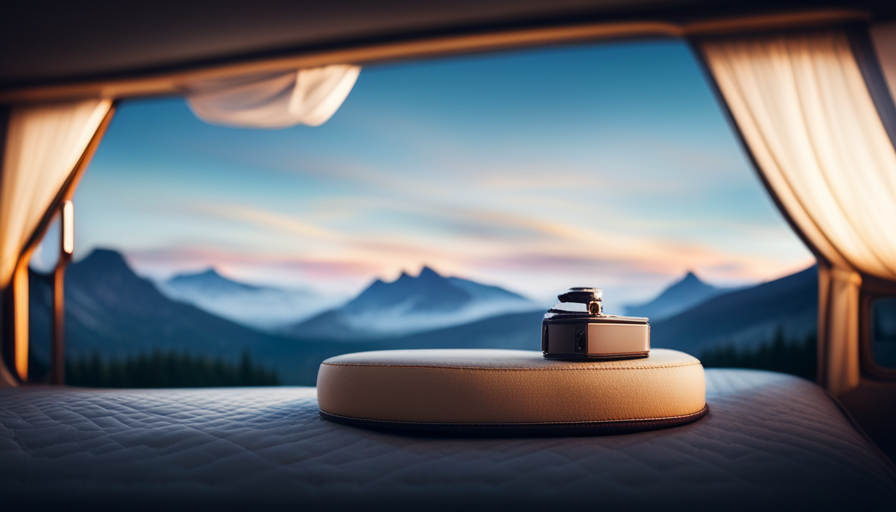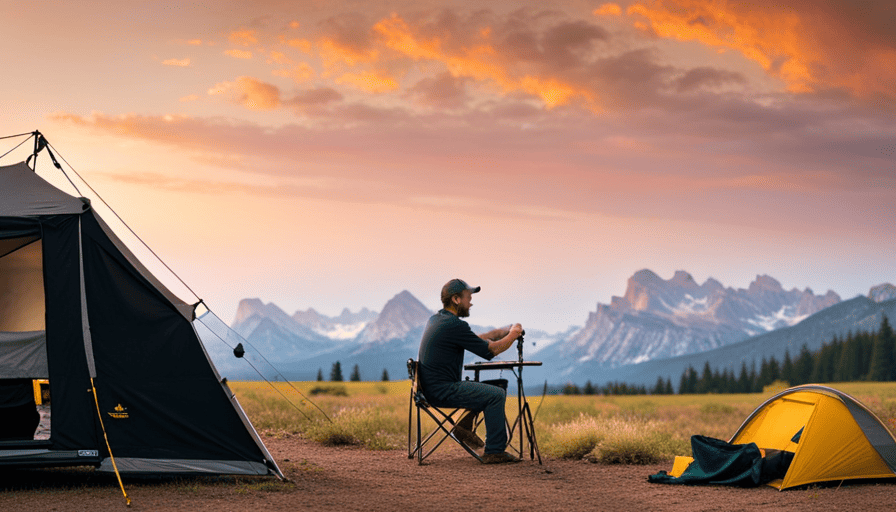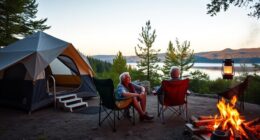Do you ever fantasize about cruising the highways with the liberty to travel to any destination that calls to you? I’m here to assure you that it’s not merely a fantasy – it’s absolutely achievable! Constructing your own camper van is the ideal method to make that dream come true.
Imagine having your own cozy, comfortable space on wheels, with all the amenities you need to live life on the road. From a kitchen area to a comfortable bed, you can create the ultimate home away from home.
In this article, I’ll take you through the step-by-step process of building your very own van camper. We’ll start by choosing the right van for your needs, then move on to planning your layout and design. From there, we’ll insulate and install flooring, build and install furniture, and even create storage solutions.
By the end of this article, you’ll have all the knowledge and confidence you need to build your own van camper and start living your dream of adventure on the road.
So, let’s get started!
Key Takeaways
- Building your own van camper is a customizable and budget-friendly option for adventure on the road.
- Proper insulation, flooring, and furniture are essential for creating a functional living space.
- Designing a solar power setup allows for off-grid living and independence.
- Creating efficient storage solutions and incorporating personal touches enhance the overall experience of van camper living.
Choose the Right Van
Choosing the right van is crucial for creating your dream camper, so don’t rush the decision! When it comes to van campers, there are a variety of customization options available, allowing you to create a space that suits your unique needs and preferences.
Before diving into the world of van conversions, it’s important to consider your budget. Vans come in different sizes and models, each with its own price range. Assess your financial situation and determine how much you’re willing to spend on the van itself, as well as the conversion process.
Additionally, think about the layout and design you envision for your camper. Do you want a cozy sleeping area, a functional kitchenette, or ample storage space? Consider your lifestyle and the activities you plan to do while on the road. This will help you determine the size and type of van that’ll best accommodate your needs.
Once you’ve chosen the right van, you can begin planning your layout and design. This involves mapping out where each component will go, such as the bed, kitchen, and bathroom. By carefully considering these factors, you can create a camper that maximizes space and functionality.
So, let’s move on to the next step and start planning your dream camper’s layout and design.
Plan Your Layout and Design
Once you’ve envisioned the perfect layout, let your imagination run wild as you map out the design of your dream mobile sanctuary. Design considerations and space optimization are crucial when planning the layout of your van camper. You want to make the most of the limited space available while creating a functional and comfortable living area.
To help you visualize your design, consider creating a table with three columns and four rows. In the first column, list the different areas of your van, such as the kitchen, sleeping area, bathroom, and storage. In the second column, jot down the specific features and equipment you want in each area. And in the third column, note any design or layout considerations you need to keep in mind.
For example, in the kitchen area, you might want to include a small sink, a compact stove, and ample storage for utensils and cookware. Consider how you’ll optimize the space by using foldable or multipurpose furniture and incorporating storage solutions like overhead cabinets or under-bed compartments.
Once you have your layout and design planned out, you can move on to the next step of insulating and installing flooring in your van camper.
Transitioning to the subsequent section about insulating and installing flooring, it’s important to ensure your van camper is well-insulated to keep it comfortable in all weather conditions.
Insulate and Install Flooring
To create a cozy and comfortable mobile sanctuary, be sure to insulate your van camper properly and install durable flooring.
Insulation is crucial to regulate the temperature inside the van and minimize noise. There are various insulation materials you can use, such as spray foam, rigid foam boards, or insulation blankets. Consider the R-value, which measures the material’s ability to resist heat flow, and choose the one that suits your needs.
When it comes to flooring options, you have a few choices depending on your preferences and budget. One popular option is vinyl flooring, which is easy to clean, waterproof, and durable. Another option is laminate flooring, which mimics the look of hardwood but is more affordable and resistant to scratches. If you prefer a more natural and rustic feel, consider hardwood or bamboo flooring, which can add warmth and character to your van.
Once you have insulated and chosen your flooring, you can move on to building and installing furniture. By utilizing the space efficiently, you can create a functional living area that meets your specific needs and enhances your van camper experience.
Build and Install Furniture
When you construct and install furniture in your mobile sanctuary, you can create a personalized and functional living space that caters to your specific needs and enhances your overall experience.
One of the most important pieces of furniture in a van camper is the bed. To build and install a bed, start by measuring the dimensions of your van and then designing a bed frame that fits perfectly. You can use plywood and 2×4 lumber to construct a sturdy frame. Make sure to secure it to the walls or floor of the van for added stability. Once the frame is built, you can add a comfortable mattress and bedding to complete your sleeping area.
In addition to the bed, it’s also essential to design and build a seating area in your van camper. This area can serve as a place to relax, eat, and even work. You can use a combination of benches and folding chairs to maximize space efficiency. Consider using lightweight materials like plywood or aluminum for the construction of the seating area. Don’t forget to include storage compartments underneath the seats to make the most of the available space.
With the bed and seating area constructed and installed, you can now move on to the next step of your van camper conversion: installing the electrical system. By following these steps, you’ll be well on your way to creating a comfortable and functional home on wheels.
Install Electrical System
Now it’s time to bring your mobile sanctuary to life with the installation of an electrical system. Designing a solar power setup for your van camper is a great way to harness renewable energy and live off the grid.
Start by calculating your power needs and determining the size of your solar panels and battery bank. Consider the appliances and devices you plan to use, such as lights, a refrigerator, and charging ports for electronics.
Once you have a design in mind, secure the solar panels to the roof of your van using mounting brackets. Next, wire the panels to a charge controller, which regulates the flow of electricity and prevents overcharging.
Connect the charge controller to your battery bank, which stores the solar energy for later use. To power your appliances and devices, install an inverter to convert the DC power from the battery bank to AC power.
Finally, ensure all wiring connections are secure and protected from damage. With your electrical system in place, you’ll be ready to enjoy the comforts of home during your van adventures.
Speaking of comforts, the next section will cover how to include a plumbing and water system in your camper.
Include Plumbing and Water System
Create a comfortable and convenient living space in your mobile sanctuary by incorporating a plumbing and water system. When it comes to plumbing installation in your van camper, it’s important to plan the layout carefully.
Start by installing a fresh water tank, which can be located underneath the van or inside a cabinet. Connect the tank to a water pump that’ll provide a steady flow of water to your fixtures. Install a sink with a small drain tank to collect wastewater. Consider using flexible PEX piping for your water supply lines, as it’s durable and easy to work with.
To ensure proper water system maintenance, regularly check for leaks and make sure all connections are secure. It’s also important to properly winterize your water system to prevent freezing during colder months. This can be done by draining the water tank and pipes, and adding antifreeze to the system.
Now that you have your plumbing and water system in place, it’s time to create storage solutions that maximize the use of space in your van camper. By incorporating clever storage solutions, you can keep your belongings organized and easily accessible while on the road.
Create Storage Solutions
Maximize the use of space in your mobile sanctuary by ingeniously designing storage solutions that seamlessly blend functionality and style.
When building a van camper, it’s crucial to prioritize maximizing space and organizing essentials. With limited square footage, every inch counts, and efficient storage solutions can make all the difference.
Start by assessing your needs and identifying the items you can’t live without. This’ll help you determine the type and size of storage units you require.
Utilize every nook and cranny by installing overhead cabinets, under-bed storage compartments, and built-in shelves. Consider using stackable containers or collapsible storage bins that can be easily tucked away when not in use.
Another clever idea is to incorporate multi-purpose furniture that doubles as storage. For example, a bench seat with a hidden storage compartment or a bed with drawers underneath. You can also hang hooks and organizers on the walls or doors to keep smaller items within reach.
Maximizing space also means utilizing vertical storage. Install shelving units that go all the way up to the ceiling, or use hanging storage systems to make use of unused wall space. Additionally, make use of the space above your cab by installing a roof rack for larger items like bikes or surfboards.
By incorporating these storage solutions into your van camper design, you can efficiently organize your essentials and maximize your living space. After all, a clutter-free and well-organized interior is a key factor in creating a comfortable and inviting mobile living space.
Add Comfort and Decor
Enhance your mobile sanctuary by incorporating elements of comfort and stylish decor. When it comes to van camping, creating a cozy and inviting space is essential.
One way to achieve this is by adding lighting options that not only illuminate the interior but also create a warm ambiance. Consider installing LED strip lights along the walls or ceiling to provide a soft glow. You can also incorporate personal style by choosing unique light fixtures or string lights that reflect your taste.
In addition to lighting, don’t forget about the importance of comfort. Invest in a quality mattress or foam topper to ensure a good night’s sleep. Add soft pillows, blankets, and curtains to create a snug atmosphere. Incorporating personal touches such as colorful throw rugs or decorative wall art can also make your van feel like home.
As you focus on adding comfort and decor, keep in mind the next step: installing appliances and creating a kitchen area. By seamlessly transitioning from enhancing the aesthetics to practical functionality, you can create a van camper that’s both comfortable and functional.
Install Appliances and Kitchen Area
Establish an efficient and equipped culinary corner to elevate your van camping experience. When it comes to installing appliances and creating a functional kitchen area in your van camper, space optimization is key. Here are four essential elements to consider:
-
Compact Refrigerator: Invest in a small yet efficient refrigerator to keep your food and drinks fresh during your van adventures. Look for one with adjustable shelves and a built-in freezer compartment.
-
Portable Stove: Opt for a portable stove that runs on propane or butane. These stoves are lightweight, easy to use, and perfect for cooking your favorite meals on the road.
-
Sink and Water System: Install a compact sink with a hand pump or electric faucet to ensure easy access to water for cooking and cleaning. Consider a water storage tank and a greywater disposal system for convenience.
-
Storage Solutions: With limited space, it’s crucial to have smart storage options. Install shelves, hooks, and compartments to keep your kitchen utensils, cookware, and pantry items organized and easily accessible.
To maintain your appliances, regularly check for leaks, clean the filters, and inspect the connections. By establishing an efficient kitchen area and properly maintaining your appliances, you’ll ensure a smooth and enjoyable van camping experience.
As you finalize and test your van camper, make sure all the appliances are functioning properly and the kitchen area is fully equipped for your adventures.
Finalize and Test Your Van Camper
Now it’s time to put the finishing touches on your converted vehicle and ensure everything’s in working order for your upcoming adventures on the road. One of the most important aspects of finalizing your van camper is testing the safety features and conducting a maintenance checklist.
First and foremost, it’s crucial to test all the safety equipment in your van camper. This includes checking the functionality of smoke detectors, carbon monoxide detectors, and fire extinguishers. Make sure they’re all properly installed and in good working condition. Additionally, test the functionality of all the windows, doors, and locks to ensure they’re secure and can be easily opened and closed.
Next, it’s essential to perform a thorough maintenance checklist. This involves inspecting the engine, checking the fluid levels, and ensuring all the lights are functioning properly. Don’t forget to inspect the tires for any signs of wear or damage, and check the tire pressure to ensure they’re properly inflated. Additionally, inspect the electrical system, including the battery and all wiring connections.
By testing the safety features and conducting a maintenance checklist, you can have peace of mind knowing that your van camper’s in optimal condition for your upcoming road trips. Prioritizing safety and maintenance will help ensure a smooth and enjoyable journey.
Frequently Asked Questions
How much does it cost to convert a van into a camper?
Converting a van into a camper can vary in cost depending on several factors. A cost breakdown typically includes expenses for insulation, flooring, electrical system, plumbing, furniture, and appliances.
To find affordable materials, I recommend checking out local salvage yards, thrift stores, and online marketplaces for used items. Additionally, joining online forums and groups dedicated to van conversions can provide helpful advice and resources for cost-effective options.
Don’t forget to budget for tools and any professional help if needed.
What are the legal requirements for converting a van into a camper?
When converting a van into a camper, it’s important to consider the legal requirements and insurance coverage.
Legal requirements may vary depending on your location, but typically involve obtaining a special vehicle registration or classification as a motorhome. This may require certain features like sleeping accommodations, cooking facilities, and a water supply.
Insurance coverage is also crucial, as you’ll need to ensure your converted camper is adequately covered for both liability and property damage.
How long does it typically take to convert a van into a camper?
Converting a van into a camper can be a time-consuming project, but with proper time management, it can be done efficiently.
The duration of the conversion process can vary depending on the complexity of the design and the skill level of the builder.
Common challenges include sourcing materials, electrical and plumbing installations, and ensuring structural integrity.
It’s important to set realistic expectations and allocate enough time to complete the project to your satisfaction.
Can I convert any type of van into a camper?
Yes, you can convert any type of van into a camper with the right van conversion tips. However, some vans are better suited for camper conversion than others. The best vans for camper conversion are typically those with a high roof, ample space for sleeping and storage, and good fuel efficiency. Popular choices include the Mercedes Sprinter, Ford Transit, and Ram Promaster. These vans provide a solid foundation for creating a comfortable and functional camper.
Are there any safety considerations I should keep in mind when converting a van into a camper?
Safety is paramount when converting a van into a camper. To ensure your well-being, consider a few vital safety measures.
First, install smoke and carbon monoxide detectors to keep you safe from potential hazards.
Second, choose insulation options that are both effective and fire-resistant. This will help regulate temperature and prevent any accidents.
Remember, prioritizing safety is key when creating your dream van camper. Don’t compromise on protecting yourself and your loved ones.
What Are the Similarities and Differences Between Building a Camper and a Van Camper?
Building a camper and a van camper have similarities and differences. When you build your own camper, you have more freedom to customize the layout and design. However, a van camper offers better maneuverability and versatility for travel. Consider your needs and preferences before embarking on the exciting journey to build your own camper.
Conclusion
In conclusion, building a van camper is an exciting and rewarding project that requires careful planning and attention to detail. By choosing the right van, designing a practical layout, and installing necessary systems, you can create a comfortable and functional home on wheels.
It may seem like a daunting task, but with a little creativity and determination, you can transform a simple van into a cozy sanctuary. So roll up your sleeves, grab your tools, and get ready to embark on this incredible journey of van conversion.
Happy camping!

